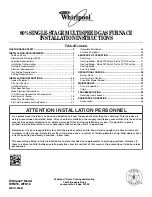
18
energized. The integrated control module electronic air cleaner
terminals (EAC) are energized with 115 volts whenever the circulator
blower is energized.
24 V
AC
H
UM
1. 24 VAC Hum - A ¼” piggy-back quick connect terminal on
the pressure switch provides 24 VAC humidifier control. This
terminal will be powered any time the pressure switch is
closed. To connect 24 VAC hum, connect 24 VAC line of
humidifier to piggyback on the pressure switch. The COM
side of the humidifier to C on the terminal strip on the control
board (or to com side to 24 VAC transformer). Do not
connect 115V humidifier to these terminals.
IX. GAS SUPPLY AND PIPING
G
ENERAL
The furnace rating plate includes the approved furnace gas input
rating and gas types. The furnace must be equipped to operate on
the type of gas applied. This includes any conversion kits required
for alternate fuels and/or high altitude.
CAUTION
T
O PREVENT UNRELIABLE OPERATION OR EQUIPMENT DAMAGE, THE INLET
GAS SUPPLY PRESSURE MUST BE AS SPECIFIED ON THE UNIT RATING PLATE
WITH ALL OTHER HOUSEHOLD GAS FIRED APPLIANCES OPERATING.
Inlet gas supply pressures must be maintained within the ranges
specified in the following table. The supply pressure must be
constant and available with all other household gas fired appliances
operating. The minimum gas supply pressure must be maintained
to prevent unreliable ignition. The maximum must not be exceeded
to prevent unit overfiring.
Natural Gas
Minimum: 5.0" w.c.
Maximum:10.0" w.c.
Propane Gas Minimum: 11.0" w.c.
Maximum:13.0" w.c.
Inlet Gas Supply Pressure
NOTE:
Adjusting the minimum supply pressure below the limits in
the above table could lead to unreliable ignition. Gas input to the
burners must not exceed the rated input shown on the rating plate.
Overfiring of the furnace can result in premature heat exchanger
failure. Gas pressures in excess of 13 inches water column can
also cause permanent damage to the gas valve.
At all altitudes, the manifold pressure must be within 0.3 inches
w.c. of that listed in the Product Data Book applicable to your model*
for the fuel used. At all altitudes and with either fuel, the air
temperature rise must be within the range listed on the furnace
nameplate. Should this appliance be converted to LP, refer to the
instructions included in the factory authorized LP conversion kit
LPT-03B
.
H
IGH
A
LTITUDE
D
ERATE
IMPORTANT NOTE:
The furnace will naturally derate itself with
altitude. Do not attempt to increase the firing rate by changing
orifices or increasing the manifold pressure. This can cause poor
combustion and equipment failure.
When this furnace is installed at high altitude, the appropriate High
Altitude orifice kit must be applied. The furnace is supplied with
orifices sized for natural gas at altitudes up to 4,500 feet using a
heating value of approximately 1,000 Btu/hr, and should not
normally require change. Most cases will not require a change at
altitudes up to 7,500 feet. For use at altitudes in excess of 4,500
feet, refer to the following table for maximum input rates based on
altitude. Contact your local gas utility for the heating value of gas.
Refer to National Fuel Gas Code ANSI Z223.1 and the following
section to calculate firing rates.
Altitude
High Fire Low Fire High Fire Low Fire High Fire Low Fire
5,000
57,000
42,000
74,000
54,000
92,000
66,500
7,500
53,000
39,000
72,000
53,000
88,000
64,500
10,000
52,000
37,500
71,000
49,000
84,000
60,500
Firing rates may be lower than listed in table
115,000 kBtu/hr input models require pressure switch change above 7,500'
Use switch B1370209
Maximum Firing Rates at Altitude
Model (Kbtu/hr)
70
90
115
It is important to check and adjust the input rate of the furnace to
prevent an overfiring situation. Overfiring can cause premature heat
exchanger failure. The input is controlled by the supply pressure,
orifice size, manifold pressure and heating (calorific) value of the
gas.
The supply pressure must be measured with this and all other gas
burning appliances in operation. The supply pressure must be
adjusted to the pressure range stated on the series and rating plate.
Applications for altitudes in excess of 4,500 feet may require an
orifice change. Alternately standard derate for altitude from National
Fuel Gas Code ANSI Z223.1 of 4% per 1000” may be taken. Refer
to the most recent version of ANSI Z223.1 for correct gas orifice.
The furnace derate is 4% for each 1,000 feet above sea level. This
table is based upon a heating value of approximately 1,000 Btu/ft
3
NAT. GAS
ORIFICE SIZE
0 - 2,000
#43
3,000
#44
4,000
#44
5,000
#45
6,000
#45
7,000
#46
ALTITUDE
The input to the furnace must be checked AFTER reorificing.
For altitudes above 7,000 feet, refer to appropriate section of the
National Fuel Gas Code, ANSI Z223.1. To calculate the input of the
furnace for installations in altitudes over 2,000 - 7,000 feet, use the
following formula:
Corrected Input = Series & Rating Plate Input - (Altitude X .04) X
(Series & Rating Plate Input / 1000)
Example:
Corrected input for a 90,000 Btu/hr. appliance installed at an altitude
of 6,000 ft. utilizing natural gas with a heating value of 1,000 Btu/ft
3
is determined by-
Corrected Input = 90,000 - (6,000 X .04) X (90,000 / 1,000)
Corrected Input = 90,000 - (240 X 90)
Corrected Input = 90,000 - 21,600
Corrected Input = 68,400















































